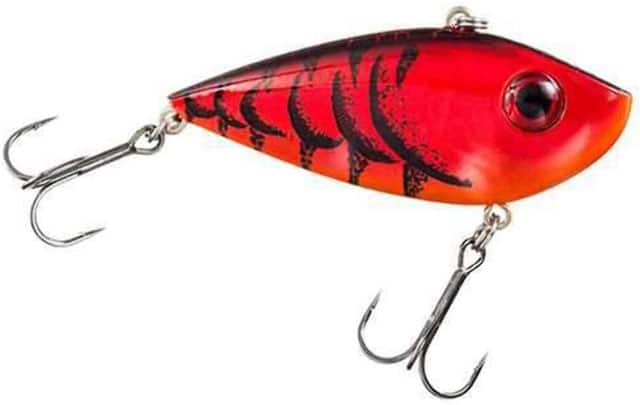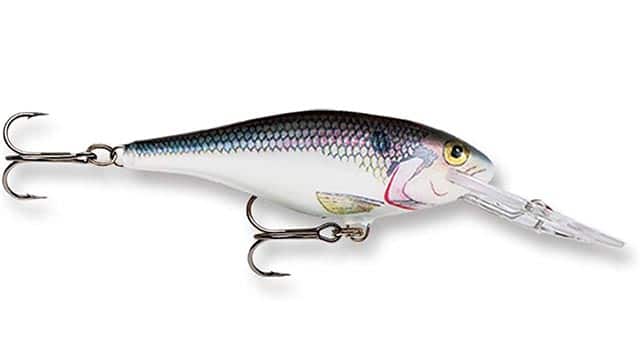During the winter, bass become lethargic and don’t want to exert a lot of energy to chase down a meal. They oftentimes are not in the mood to feed when the water temperatures drop.
Getting bass to react to a lure is often key to triggering them to strike in cold conditions. Crankbaits are a great technique to get those lazy bass to react and strike a lure. They are great shad imitators and often irritate bass enough for fish to strike them.
In cold water, I like to stick with two types of crankbaits when on the hunt for big bass:
Lipless Crankbaits for Coldwater
As the name implies, a lipless crankbait has no lip and no buoyancy, therefore it sinks, unlike a sqaurebill crankbait. A lipless crankbait shudders just like an injured baitfish. Because of all the slow-moving, struggling shad in most fisheries during the winter, I prefer a lipless crankbait because its falling action mimics those baitfish very well.

Strike King Red Eye Shad
My number one choice when throwing a lipless crankbait has to be the Strike King Red Eye Shad. It’s has a super realistic appearance and great action. The lure comes in many different colors and sizes, and works in many situations.
3 Best Lipless Crankbaits
All three of these lures are great lipless crankbaits for cold-water bass. Each has excellent, lifelike features and action, and are offered in a variety of styles. If a Red Eye Shad isn’t available, I reach for a One Knocker or Rattle Trap.
| Rank | Picture | Name | Where to Buy |
|---|---|---|---|
| 1 |  | Strike King Red Eye Shad | See it on Amazon |
| 2 |  | Booyah Baits One Knocker | See it on Amazon |
| 3 |  | Bill Lewis Rattle Trap | See it on Amazon |
4 Lipless Crankbait Tips
1. Start With a ½ Ounce Bait
Typically, when I’m throwing a lipless crankbait, a ½ ounce bait is my preferred size. However, I will sometimes go to a ¾ or 1-ounce lure when targeting fish in deeper water and want the lure to fall faster.
2. Bright Colors Excel
There are a ton of different colors, but I like to keep it simple. Craw, chartreuse, and some type of gray shad pattern are the three colors I prefer this time of year.
With a lot of fisheries being muddied by winter rain, the craw and bright chartreuse patterns stick out in dingy water.
Plus, the shad this time of year are usually more of a dull color and the grayish shad patterns better imitate those baitfish.
3. Use the Yo-Yo Retrieve
The best wintertime retrieve for a lipless crankbait is referred to as the yo-yo style retrieve. When employing this technique, anglers should allow their lure to fall to the bottom.
Once it touches the bottom, jerking the rod upwards or to the side hops the bait off the bottom, giving it the yo-yo style retrieve. Bass will most often strike a lipless crankbait on the fall, as it is sinking towards the lake floor.
4. What to Look For
Channels, creeks, shell bars, sand bars, ledges, drop-offs, points, along boat docks, and over the top of grass are all great areas to fish a lipless crankbait during the winter.
Also, if you come across bass that are schooling, whether at the surface or sub-surface, a lipless crankbait is one of the best options for that scenario.
Flat-side Crankbaits for Coldwater
If a lipless crankbait isn’t the ticket, I turn to a flat-side crankbait.
Unlike a lipless crankbait, a flat side crankbait has a bill and floats on the surface until it’s retrieved.
Flat-side crankbaits have a much tighter wobble and swimming action than a traditional round bodied crankbait.
For example, a Strike King KVD 1.5 squarebill crankbait swims tighter and is more subtle than a Strike King 1.5 Flat Side squarebill crankbait.
That flat side allows these crankbaits to imitate shad better during the winter and makes them an excellent choice this time of year.

Rapala Shad Rap
The Rapala Shad Rap is my favorite when it comes to flat-side crankbaits. The lure has a tight wobble and mimics those slow-moving shad very well. The Shad rap is offered in several sizes, but I prefer the 07 and 09 sizes of the bait.
4 Best Flat-Side Crankbaits
| Rank | Picture | Name | Where to Buy |
|---|---|---|---|
| 1 |  | Rapala Shad Rap | See it on Amazon |
| 2 |  | Rapala DT-6 | See it on Amazon |
| 3 |  | Rapala BX Brat | See it on Amazon |
| 4 | Strike King KVD 1.5 Flat Side | See it on Amazon | |
Each of these lures are an excellent choice when it comes to flat-side crankbaits. The DT-6 is meant to dive up to 6 feet, so I turn to it when I want a medium diving lure. The BX Brat and Strike King KVD 1.5 Flat Side are awesome options if you’re looking for a durable squarebill crankbait for fishing around shallow hard cover, such as stumps and rocks.
3 Flat-Side Crankbait Tips
Use a Stop and Go Retrieve
Instead of simply steadily retrieving a flat-side crankbait, using a stop and go retrieve is often key when crankbait fishing, especially during the winter. Those bass are most likely not going to run a bait down from a good distance away. But if you pause the bait in the strike zone and keep it there, it gives those fish more of an opportunity to attack the lure.
If you are fishing around structure, pausing the crankbait when it deflects off the cover can often trigger strikes. But, if your fishing open water and not hitting any bottom structure, it’s a good idea to pause the bait every few seconds to give it the same look as if it were deflecting off cover.
Color and Size
I use the same craw, chartreuse, and dull gray color patterns as I do for lipless crankbaits. I also try to vary the size of my lure based on the size of the forage in the body of water I’m fishing.
Fish Hard Structure
When fishing a flat-side crankbait, focus on any type of hard structure, such as logs, stumps, brush piles, rocks, or sand bars. Remember to pause the bait any time it comes into contact with the bottom and it may trigger a strike.
Things to Consider
Crankbait Tackle
For both lipless and flat-side crankbaits, I prefer a 7’ medium action baitcasting rod with a rather soft tip, paired to a slower speed reel, with a 5:4:1 gear ratio. The slower reel allows anglers to move the lure slower and keep the bait in the strike zone longer.
I spool that reel with 12-17 pound fluorocarbon line. The size of the line I use depends on the depth I’m fishing, and the clarity of the water. The clearer the water and the deeper I’m fishing, the lighter I’ll go.
Pay Attention to Sound
It is also important to keep in mind the sound that your crankbait makes. In most clear water situations, I like to throw a silent bait, with no rattles, that makes very little noise when brought through the water.
In contrast, if I’m fishing murky or stained water, I prefer a crankbait with rattles that makes plenty of noise, which allows bass to locate it better.
Be Open Minded
If you have a graph or depth finder, use it to search for cover, ledges, drop-offs, baitfish and bass beneath the surface. Also keep an eye out for birds crashing the water to feed on bait that are near the surface. Where there are birds there are often bass not far away.
Focus on structure and don’t be afraid to fish both shallow and deep water. If you can, try your best to stay committed to a crankbait for most of the day and build your skill with it. You may be surprised at what it will catch!
Back to You
Targeting wintertime bass can be tricky, but if you are willing to brave the cold weather and put in time and effort on the water, you can catch some big bass this time of year on a crankbait pattern. So, if you’re planning to take a trip to the lake this winter don’t forget to throw a few lipless and flat-side crankbaits in your tackle box.
Remember, my top lipless crankbait is the Red Eye Shad and my top flat-side crankbait is the Rapala Shad Rap.
Thank you so much for reading! I hope you guys enjoyed the article. If so, be sure to subscribe to the website, smash that notification button and check out our YouTube for some awesome fishing videos and additional tips!
Give some of these tactics a try on your next outing. Leave a comment below to let us know how it goes and what your favorite wintertime crankbait is!
